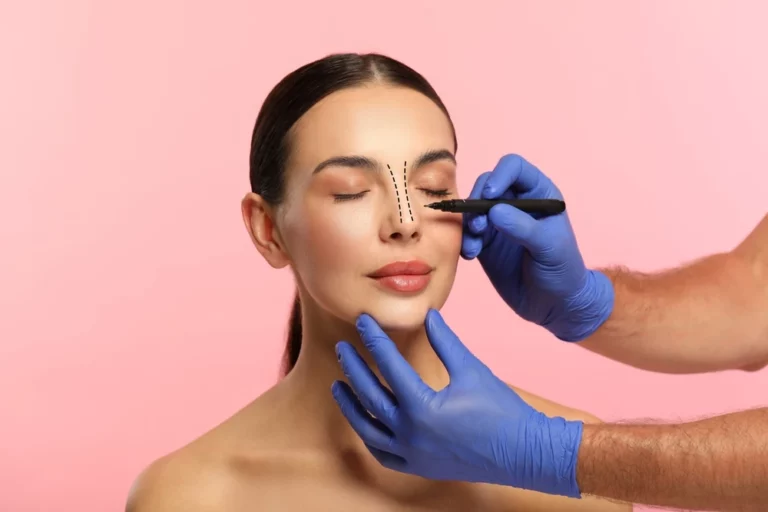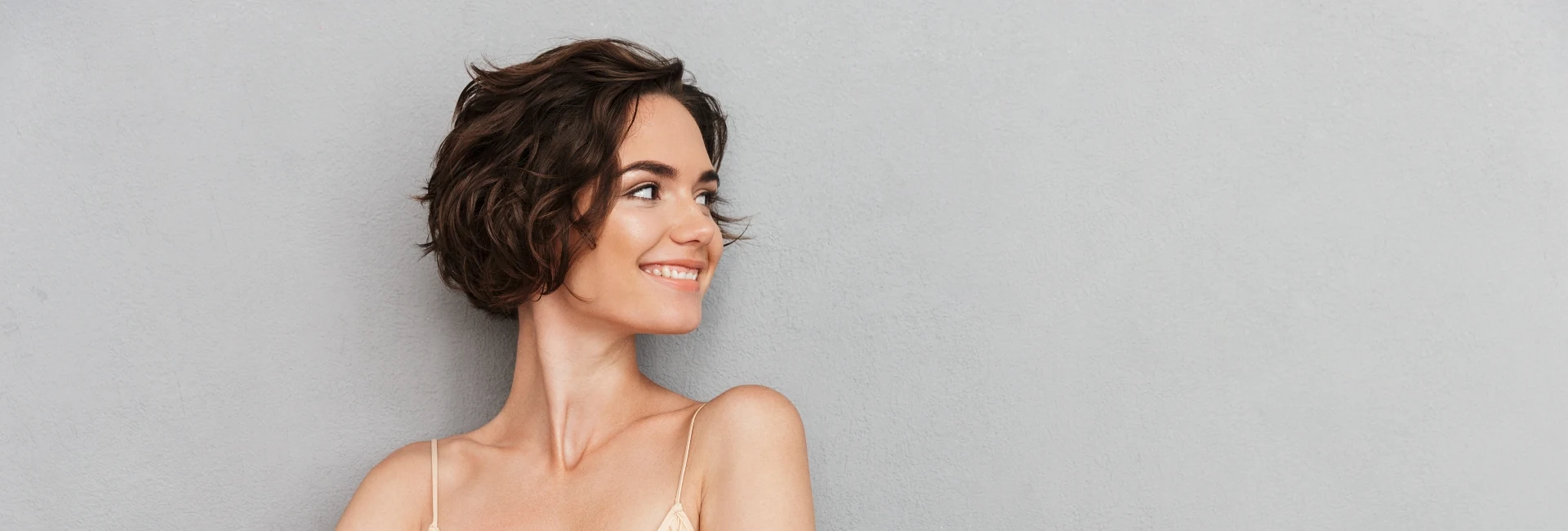Pinched Nasal Tip Correction
Pinched nasal tip correction is a surgical procedure aimed at restoring nasal harmony and function by addressing deformities in the nasal tip region. This article delves into the intricate surface aesthetics and surgical techniques crucial for achieving optimal results in pinched nasal tip correction. Dr. David Cangello, a leading board-certified plastic surgeon in New York City, specializes in pinched nasal tip correction, offering state-of-the-art techniques to help you achieve the natural, balanced nasal appearance you desire.
Understanding Aesthetic Nasal Polygons
Understanding Aesthetic Nasal Polygons
Understanding the surface aesthetics of the nose requires a meticulous analysis of its geometric polygons.1 These polygons serve as aesthetic subunits, delineating the lines, shadows, and highlights that define nasal appearance. By evaluating these polygons, Dr. Cangello can identify deformities and plan surgical interventions to achieve symmetrical and aesthetically pleasing outcomes.

Dorsal and Lateral Aesthetic Lines
The dorsal and lateral aesthetic lines play pivotal roles in nasal aesthetics. Traditionally depicted as concave lines, these aesthetics are redefined through the lens of geometric polygons. The dorsal aesthetic lines, originating from the glabella and extending to the nasal tip, create a fusiform pattern crucial for a natural-looking dorsum. Similarly, lateral aesthetic lines accentuate nasal triangularity, offsetting the nose from the cheek and contributing to overall facial balance.

Scroll Line and Lateral Crus Resting Angle
The scroll line, marking the transition between the upper lateral and lateral crus, and the lateral crus resting angle are key determinants of nasal tip aesthetics. The groove over the scroll area influences the supratip breakpoint, while the resting angle of the lateral crus impacts tip projection and definition. Understanding these dynamic aspects is essential for achieving desired nasal tip contours.
Nasal Tip Diamond
The nasal tip diamond, characterized by double light reflections, embodies ideal tip aesthetics. This diamond shape results from the interaction of dome triangles, interdomal triangles, and infralobular polygons. The precise definition of tip-defining points facilitates the creation of aesthetically pleasing tip contours, enhancing overall nasal appearance.
Understanding Pinched Nasal Tip Deformity
A pinched nasal tip occurs when the lower lateral cartilages, which shape the tip of the nose, are overly narrowed or weakened, resulting in malposition of the lateral crus of the lower lateral cartilage. The malposition results in an obtuse lateral crural resting angle, which may lead to the collapse of the nostrils and a pinched tip appearance (Fig.1). It can also occur from an overdone supratip break from previous rhinoplasty surgery.2 This can create a noticeable indentation or constriction in the nasal tip, detracting from the overall harmony of your facial features. In addition to its impact on appearance, a pinched nasal tip can lead to breathing difficulties by narrowing the nasal airway.
Preparing for Pinched Nasal Tip Correction
Before undergoing pinched nasal tip correction with Dr. Cangello, it’s essential to schedule a comprehensive consultation to discuss your concerns and goals. During this initial meeting, Dr. Cangello will assess your nasal anatomy and develop a personalized treatment plan tailored to your unique needs. You’ll receive detailed instructions to help you prepare for surgery, including guidelines for medication management, smoking cessation, and arranging for post-operative care.
The Pinched Nasal Tip Correction Procedure
Pinched nasal tip correction demands surgical finesse and adherence to aesthetic principles. Specialized suture and other techniques are aimed at correcting the lateral crural resting angle, which is much too obtuse in a pinched tip nose and critical for correcting the pinched tip. The cephalic dome suture corrects the resting angle of the lateral crus, enhancing tip projection and definition. Conversely, the Libra graft recreates dorsal aesthetics by repositioning excised cartilage, achieving natural fusiform lines and contours.

Dr. Cangello employs advanced surgical techniques to correct a pinched nasal tip and restore balance to the nose. Depending on your specific needs, he may recommend either an open or closed rhinoplasty approach. During the procedure, Dr. Cangello may use some or all of the following methods to address the underlying causes of your pinched nasal tip:
1. Preoperative Evaluation and Markings
Before surgery, Dr. Cangello evaluates the nasal anatomy and discusses the patient’s aesthetic goals. He will then mark the existing and desired nasal tip on the lateral cheek skin to simulate the expected surgical outcome.
2. Incisions
The surgical approach may be open or closed, depending on the complexity of the case. In open rhinoplasty, a V-shaped incision across the columella provides direct access to the nasal structures, while closed rhinoplasty involves incisions within the nostrils. Care is taken to retain the superficial musculoaponeurotic system (SMAS) during the open approach to prevent post-operative depression.
3. Cartilage Reconstruction and Grafting
When previous rhinoplasty procedures result in an over-resection of cartilage, leading to a pinched nasal tip, Dr. Cangello utilizes advanced cartilage reconstruction techniques to restore a balanced appearance. Depending on the extent of the damage and your specific needs, he may opt for either septal, ear, or rib cartilage for grafting.
4. Management of Lateral Crura
When the lateral crura is over-resected, it can cause the tip to appear pinched and the nostrils to collapse. In these cases, reconstruction is necessary to restore a balanced appearance. Dr. Cangello employs lateral crural strut grafts to reconstruct and reinforce the lateral crura. Dr. Cangello addresses this by using lateral crural strut grafts to rebuild the crura, correcting the pinched effect. This is followed by precise suturing techniques to orient the crura properly, ensuring the nostrils are no longer collapsed, and the nasal tip achieves a refined, diamond-shaped contour.
5. Cartilage Dissection and Marking
Dissection is performed in the subperichondrial/subperiosteal plane to control midline and scroll ligaments and enable precise cartilage shaping. Cartilages are marked to ensure correct manipulation, especially in cases of asymmetric tips.
6. Dome-Defining Point Identification
Precise identification of the dome-defining point is crucial for proper reshaping of the nasal tip. Symmetric reference markings are made on the lateral crura to ensure alignment and symmetry.
7. Cephalic Dome Sutures
Cephalic dome sutures stabilize the middle and lateral crura, correct resting angles, and define the position of the dome. These sutures may be used to compensate for lost projection caused by footplate setback.
8. Dome-Equalizing Suture
Once the domes are positioned appropriately, a dome-equalizing figure-of-8 suture is placed to stabilize them. This step ensures symmetry and proper tip rotation.
9. Columellar Strut Graft
A curved columellar strut graft may be placed to support the nasal tip and maintain proper polygonal aesthetics. Positioning the strut cephalically prevents visibility and facilitates polygonal reconstruction. A specialized septal extension graft, developed by Dr. Cangello, is used in lieu of a strut in certain cases where more strength and projection of the lateral crura is desired than can be accomplished with a columellar strut. This is more often the case in noses with very thick skin and/or weak lower lateral cartilages.
10. C′ Breakpoint Remodeling
Reshaping of the C′ breakpoint is performed to enhance nasal tip surface aesthetics. A suture is placed to redefine the transition line between the infralobular and columellar polygons.
11. Redraping
Finally, the skin is redraped to ensure correct reduction and settling of soft tissue components. Careful attention is paid to maintaining symmetry and stability, crucial for achieving optimal nasal tip aesthetics.
By following these meticulous steps, Dr. Cangello achieves desirable nasal tip aesthetics while maintaining structural integrity and functional harmony. Proper preoperative planning and precise execution are essential for successful outcomes in pinched nasal tip correction surgery.
Recovery After Pinched Nasal Tip Correction
Following pinched nasal tip correction surgery, patients can expect some initial swelling and bruising, which typically resolve over the following weeks. Dr. Cangello will provide detailed post-operative care instructions to help minimize discomfort and promote optimal healing. Patients are encouraged to rest and avoid strenuous activities during the initial recovery period, allowing their bodies to adjust to the newly refined nasal contours. Dr. Cangello will schedule follow-up appointments to monitor your progress and ensure a smooth recovery process.
Schedule a Consultation for Pinched Nasal Tip Correction
Pinched nasal tip correction is a nuanced surgical endeavor guided by surface aesthetics and precise techniques. By embracing geometric polygons and dynamic nasal structures, Dr. Cangello sculpts aesthetically pleasing noses while preserving functionality. Through meticulous analysis and surgical artistry, pinched nasal tip correction can yield transformative outcomes, restoring confidence and harmony to patients’ facial profiles.
If you’re bothered by a pinched nasal tip and are considering corrective surgery, contact us to schedule a private consultation with Dr. David Cangello in Manhattan today.
FAQs About Pinched Nasal Tip Correction
Candidates for pinched nasal tip correction surgery typically exhibit nasal tip deformities characterized by excessive narrowing or constriction. If you’re bothered by a nasal tip that appears overly pinched or lacks proper definition, you may be a suitable candidate. However, candidacy ultimately depends on an evaluation by Dr. Cangello, who will assess your nasal anatomy, medical history, and aesthetic goals to determine the appropriateness of the procedure for you.
In open rhinoplasty, a small incision is made across the columella (the strip of tissue separating the nostrils) to provide direct access to the nasal structures, allowing for more extensive modifications. Closed rhinoplasty, on the other hand, involves incisions made within the nostrils, offering limited visibility and access to the nasal tip. Both techniques may be utilized to correct a pinched nasal tip, depending on the complexity of the case and Dr. Cangello’s preference. Open rhinoplasty provides superior visibility and precision, making it preferred for intricate corrections, while closed rhinoplasty offers faster recovery and minimal scarring.
After pinched nasal tip correction surgery, you can expect some swelling, bruising, and discomfort around the nasal region. You may also experience congestion and mild bleeding in the initial days following surgery. It’s essential to follow Dr. Cangello’s post-operative instructions diligently, which may include wearing a nasal splint, avoiding strenuous activities, and taking prescribed medications to manage pain and reduce the risk of infection. Recovery times vary among individuals, but most patients can resume light activities within a week, with full recovery and final results typically achieved within several months.
As with any surgical procedure, pinched nasal tip correction surgery carries inherent risks and potential complications. These may include infection, bleeding, adverse reactions to anesthesia, asymmetry, scarring, nasal airway obstruction, and dissatisfaction with aesthetic outcomes. To mitigate these risks, it’s crucial to choose a board-certified plastic surgeon like Dr. Cangello, who is experienced in rhinoplasty procedures.
In most cases, pinched nasal tip correction surgery is considered a cosmetic procedure and, therefore, not covered by insurance. However, if nasal breathing difficulties accompany the nasal deformity, insurance may provide coverage for functional rhinoplasty to address both cosmetic and functional concerns. It’s advisable to consult with your insurance provider and Dr. Cangello to understand coverage options and potential out-of-pocket expenses.
While initial improvements may be visible soon after surgery, final results of pinched nasal tip correction surgery typically become apparent once swelling and bruising subside completely. Because Dr. Cangello uses Piezo ultrasonic rhinoplasty, swelling is significantly diminished, and results can typically be seen within several weeks instead of months. Patience is essential during the recovery period, as final outcomes may continue to refine over time, ultimately revealing a more defined and balanced nasal appearance.
Yes, pinched nasal tip correction surgery can be combined with other cosmetic or functional procedures to address additional concerns and achieve comprehensive facial harmony. Common adjunct procedures include septoplasty (to correct a deviated septum), dorsal hump reduction, nasal bridge surgery, or chin augmentation to enhance overall facial proportions. Dr. Cangello will assess your individual needs and goals to create a customized treatment plan tailored to achieve optimal results.
2 Plastic and Aesthetic Research. Nasal dorsal aesthetic lines and rhinoplasty technical tricks. https://www.oaepublish.com/articles/2347-9264.169495. Accessed July 10, 2024.
